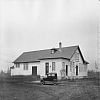Beginnings

From the beginning, the Faculty faced several hardships, including the dispersion of its students due to World War I. During the first five years of the Faculty, agriculture students were sensitive to their position in the University and felt that Agriculture would be "looked down upon". However, the splendid work done by Harold Thornton and Jack McAllister in the matter of reorganization after WWI put an end, for all time, to those early complexes.
When, in 1918, the Faculty of Agriculture (known today at the Faculty of Agriculture, Forestry, and Home Economics) was established at the University of Alberta, it played a key role in the establishment of a special course for soldiers. Many had returned from military service overseas and were suffering from some sort of disability. Several of these men were looking forward to a life on a farm and were looking and hoping for some assistance in obtaining land. However, they were receiving very little assistance. Eventually, the Dominion government launched a program aimed at training those soldiers who wanted to farm. While a school was started at Calgary, it was little more than a tractor school.
In Edmonton, Dean Howes approached Premier Charles Stewart to allow him to go to Ottawa to learn why there was a delay in establishing a course in Edmonton. He learned that members of the University's Faculty of Agriculture had been described as a bunch of well-meaning but rather impractical men who would be simply out of their depth if they were given the task of instructing returned men. Howes' discourse succeeded in swaying Ottawa officials: they paid a tuition fee for each soldier student, and Alberta bore the cost of extra equipment.

With an initial enrollment of 110, the soldiers' course began in 1918 and consisted of five units, each a month in duration and tailored to meet the needs of inexperienced men who wanted to farm. A soldier could enroll at the beginning of any month and study animal husbandry, field crops, soils, horticulture, dairying, poultry, blacksmithing, and carpentry. During the first year of the agricultural course, there was no University Farm proper nor were there any of the facilities normally associated with agriculture. Lectures in the arts and science subjects and laboratory periods were held in the Arts Building, while lectures in a few agricultural subjects were given in the north wing of Pembina Hall. Meanwhile, the occasional "laboratory" in animal husbandry was held in a small barn immediately west of Athabasca Hall.
By the opening of the 1916–1917 term, certain land south and west of the University Hospital had been cleared and a combined beef and dairy barn had been erected. Certain experimental plots had been laid out close to the main University buildings. Agriculture was becoming established in the vicinity of the university. In the fall of 1917, the presence of agriculture was made very evident through an experiment which consisted of pasturing a considerable flock of sheep on the campus in front of the three residence buildings.
Small areas close to the University buildings were made available to the Departments of Animal Husbandry, Field Husbandry, and Horticulture. A more substantial area, located approximately two miles south of the University proper was purchased for an animal husbandry farm, and a small tract was set aside for the use of the Soils Department.

A collection of barns occupied a site west of the University Hospital from 1917 to 1930. With the erection of the Normal School in 1929, it became clear that it was neither appropriate nor feasible to maintain an animal husbandry unit so close to the University. Accordingly, in 1930, the barns were put on wheels and "rolled" out to their present location. Additional buildings, including a dairy barn, judging pavilion, elevator, and tool shed were provided; this is how the present University Livestock Farm came into being.
It is clear from the above that farming was considered largely as an art, and experience was a farmer's greatest asset. It was because of this that the Faculty of Agriculture was organized.